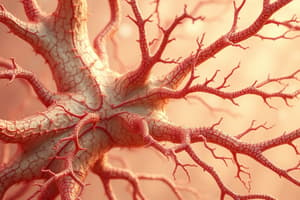Podcast
Questions and Answers
The soma forms a cone-shaped _______ as it projects to form an axon.
The soma forms a cone-shaped _______ as it projects to form an axon.
axon or hillock
_______ are small, distal branches of an axon.
_______ are small, distal branches of an axon.
telodendria
Either Schwann cells or extensions of _______ can form myelin sheaths.
Either Schwann cells or extensions of _______ can form myelin sheaths.
oligodendrocytes
The gaps between the segments of a myelin sheath are called _______.
The gaps between the segments of a myelin sheath are called _______.
A group of myelinated fibers may form a region of nerve tissue called _______ matter.
A group of myelinated fibers may form a region of nerve tissue called _______ matter.
The _______ neuron connects an afferent neuron to an efferent neuron.
The _______ neuron connects an afferent neuron to an efferent neuron.
A junction between two neurons, or between a neuron and effector, is called a(n) _______.
A junction between two neurons, or between a neuron and effector, is called a(n) _______.
A bundle of parallel neurons encased in fibrous connective tissue is called a(n) _______ (in the PNS).
A bundle of parallel neurons encased in fibrous connective tissue is called a(n) _______ (in the PNS).
A bundle of parallel neurons in the CNS is called a(n) _______.
A bundle of parallel neurons in the CNS is called a(n) _______.
An action potential traveling down a myelinated axon travels _______ (faster/slower) than in an unmyelinated axon.
An action potential traveling down a myelinated axon travels _______ (faster/slower) than in an unmyelinated axon.
Unmyelinated nerve tissue is called _______ matter.
Unmyelinated nerve tissue is called _______ matter.
_______ neurons have exactly two projections from the cell body.
_______ neurons have exactly two projections from the cell body.
_______ neurons have multiple dendrites and a single axon extending from the cell body.
_______ neurons have multiple dendrites and a single axon extending from the cell body.
In _______ neurons, a single process from the cell body diverges to form two long branches--one acting as a dendrite and the other as an axon.
In _______ neurons, a single process from the cell body diverges to form two long branches--one acting as a dendrite and the other as an axon.
Schwann cells form myelin sheaths in the _______ nervous system.
Schwann cells form myelin sheaths in the _______ nervous system.
Oligodendrocytes form myelin sheaths in the _______ nervous system.
Oligodendrocytes form myelin sheaths in the _______ nervous system.
Neuroglial cells called _______ cells line the fluid spaces of the brain.
Neuroglial cells called _______ cells line the fluid spaces of the brain.
Small glial cells that phagocytize harmful matter are called _______.
Small glial cells that phagocytize harmful matter are called _______.
_______ are ciliated neuroglia that assist the circulation of CSF.
_______ are ciliated neuroglia that assist the circulation of CSF.
Of the two major types of cells in the nerve tissue, the _______ is the most numerous.
Of the two major types of cells in the nerve tissue, the _______ is the most numerous.
Flashcards are hidden until you start studying
Study Notes
Nerve Tissue Study Notes
- The axon hillock is the cone-shaped projection formed by the soma when it transitions into an axon.
- Telodendria are small branches located at the distal end of an axon.
- Oligodendrocytes or Schwann cells are responsible for creating myelin sheaths around nerve fibers.
- Nodes of Ranvier are gaps found between segments of the myelin sheath, enhancing signal transmission.
- Myelinated fibers group together to form white matter within nerve tissue.
- Interneurons, also known as association neurons, facilitate communication between afferent (sensory) and efferent (motor) neurons.
- A synapse is the connection point between two neurons or between a neuron and an effector organ.
- Nerves consist of bundles of parallel neurons surrounded by fibrous connective tissue, specifically in the peripheral nervous system (PNS).
- In the central nervous system (CNS), a grouping of parallel neurons is referred to as tracts.
- Action potentials travel faster in myelinated axons compared to unmyelinated axons, due to increased conduction efficiency.
- Unmyelinated nerve tissue is classified as gray matter.
- Bipolar neurons are characterized by having two distinct projections extending from the cell body.
- Multipolar neurons have multiple dendrites and a single axon emanating from the cell body.
- Unipolar neurons, also known as pseudounipolar neurons, have a single process that splits into two branches: one acts like a dendrite and the other functions as an axon.
- Schwann cells are responsible for forming myelin sheaths in the peripheral nervous system.
- Oligodendrocytes create myelin sheaths in the central nervous system.
- Ependymal cells are a type of neuroglial cell that line the brain's fluid spaces and assist in the circulation of cerebrospinal fluid (CSF).
- Microglia are small glial cells that perform phagocytosis to remove harmful debris in the nervous system.
- Ependymal cells are ciliated neuroglia that help circulate cerebrospinal fluid.
- Glial cells outnumber neurons and play a critical role in supporting the nervous system.
Studying That Suits You
Use AI to generate personalized quizzes and flashcards to suit your learning preferences.



